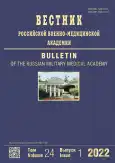Features of treatment of ureteral injuries
- Authors: Shanava G.S.1,2, Mosoyan M.S.2,3, Protoshchak V.V.4, Soroka I.V.1, Nalivaiko A.D.4, Putrenok D.G.1, Orlov D.N.4
-
Affiliations:
- Saint Petersburg I.I. Dzanelidze Research Institute of Emergency Medicine
- Almazov National Medical Research Centre
- Academician I.P. Pavlov First Saint Petersburg State Medical University
- Military medical academy of S.M. Kirov
- Issue: Vol 24, No 1 (2022)
- Pages: 35-42
- Section: Original Study Article
- URL: https://journals.rcsi.science/1682-7392/article/view/99804
- DOI: https://doi.org/10.17816/brmma99804
- ID: 99804
Cite item
Abstract
Choosing the optimal techniques for the treatment of ureteral injuries is necessary. Damage to the ureter accounts for < 3% of cases of injuries of the genitourinary system. More than 70% of iatrogenic ureteric injuries are not detected during surgery. Approximately 75%–80% of ureterotraumas are due to iatrogenic causes, of which 65%–82% are due to gynecological surgeries. Mechanical injuries of the ureter are much less common than iatrogenic ones. Gunshot and stab wounds of the ureter prevail among mechanical injuries. Thirty-one patients who were treated at the I.I. Janelidze Research Institute of Emergency Medicine with various ureteral injuries from 2003 to 2019 were examined. Patients were divided into three groups according to the time of detection of ureteral injury. Group 1 included patients with ureteral injuries identified during surgery, group 2 included those with ureteral injuries diagnosed within 72 h, and group 3 consisted of patients with ureteral injures detected > 72 h later. The choice of treatment techniques for ureterotrauma relied on the general condition of the patient, severity and level of damage to the ureter, timing of its diagnosis, and nature of the complications. On intraoperative detection of ureterotrauma in patients with a stable condition, reconstructive surgery of the ureter should be performed immediately to ensure the passage of urine from the upper urinary tract. If ureterotrauma is diagnosed before 72 h and there are no inflammatory complications, reconstructive ureteral surgery is also appropriate. If an infectious and inflammatory process develops, a staged operation is necessary to drain the upper urinary tract and relieve the developed posttraumatic complications. When ureterotrauma is diagnosed > 72 h later, a staged operation is performed to eliminate complications and drainage of the upper urinary tract. Reconstructive surgery is performed not earlier than after 2 months.
Full Text
##article.viewOnOriginalSite##About the authors
Gocha S. Shanava
Saint Petersburg I.I. Dzanelidze Research Institute of Emergency Medicine; Almazov National Medical Research Centre
Author for correspondence.
Email: dr.shanavag@mail.ru
SPIN-code: 1706-7410
candidate of medical sciences
Russian Federation, Saint Petersburg; Saint PetersburgMichail S. Mosoyan
Almazov National Medical Research Centre; Academician I.P. Pavlov First Saint Petersburg State Medical University
Email: moso3@yandex.ru
SPIN-code: 5716-9089
Scopus Author ID: 57041359200
doctor of medical sciences
Russian Federation, Saint-Petersburg; Saint PetersburgVladimir V. Protoshchak
Military medical academy of S.M. Kirov
Email: protoshakurology@mail.ru
ORCID iD: 0000-0002-4996-2927
SPIN-code: 6289-4250
doctor of medical sciences, professor
Russian Federation, Saint PetersburgIgor V. Soroka
Saint Petersburg I.I. Dzanelidze Research Institute of Emergency Medicine
Email: drsoroc@rambler.ru
Scopus Author ID: 560248
Russian Federation, Saint Petersburg
Anastasia D. Nalivaiko
Military medical academy of S.M. Kirov
Email: nastenka.nalivayko@mail.ru
SPIN-code: 6157-8394
Russian Federation, Saint Petersburg
Dmitriy G. Putrenok
Saint Petersburg I.I. Dzanelidze Research Institute of Emergency Medicine
Email: petite_femme061294@mail.ru
SPIN-code: 6278-2122
Russian Federation, Saint Petersburg
Dmytriy N. Orlov
Military medical academy of S.M. Kirov
Email: d.n.orlov@mail.ru
Russian Federation, Saint Petersburg
References
- Ledderose S, Beck V, Chaloupka M, et al. Management von Harnleiterverletzungen. Urologe. 2019;58:197–206. doi: 10.1007/s00120_019_0864-y
- Shevchyuk IM, Alekseev BYa, Shevchyuk AS. Iatrogenic ureteral injury in gynecologic oncology practice. Current state of the problem. Onkoginekologiya. 2017;(4):56–65. (In Russ.).
- Burks FN, Santucci RA. Management of iatrogenic ureteral injury. Ther Adv Urol. 2014;6(3):115–124. doi: 10.1177/1756287214526767
- Lee JS, Choe JH, Lee HS, Seo JT. Urologic Complications Following Obstetric and Gynecologic Surgery. Korean J Urol. 2012;53(11):795–799. doi: 10.4111/kju.2012.53.795
- El-Abd AS, El-Abd SA, El-Enen MA, et al. Immediate and late management of iatrogenic ureteric injuries: 28 years of experience. Arab J Urol. 2015;13(4):250–257. DOI: 10.1016/ j.aju.2015.07.004
- Smith AP, Bazinet A, Liberman D. Iatrogenic ureteral injury after gynecological surgery. Can Urol Assoc J. 2019;13(6S4):S51–S55. doi: 10.5489/cuaj.5936
- Jhaveri JK, Penna FJ, Diaz-Insua M, et al. Ureteral injures sustained during robot-assisted radical prostatectomy. J Endourol. 2014;28(3):318–324. DOI: 101089/end.2013.0564
- Zaid UB, Bayne DB, Harris CR, et al. Penetrating Trauma to the Ureter, Bladder, and Urethra. Curr Trauma Rep. 2015;1:119–124. doi: 10.1007/s40719-015-0015-x
- Fraga GP, Borges GM, Mantovani M, et al. Penetrating ureteral trauma. Int Braz J Urol. 2007;33(2):124–128. doi: 10.1590/s1677-55382007000200003
- Kadhim M, Nassr MM, Al Jufaili JS. Delayed Diagnosis of Ureteral Injury Following Penetrating Abdominal Trauma: A Case Report and Review of the Literature. Am J Case Rep. 2017;18:1377–1381. doi: 10.12659/ajcr.905702
- Pereira BM, Ogilvie MP, Gomez-Rodriguez JC, et al. A review of ureteral injuries after external trauma. Scand J Trauma Resusc Emerg Med. 2010;18:6. DOI: 10.11.86/1757-7241-18-6
- Tsyganov SV, Safazada RR, Sobolev AS. Minimally invasive treatment of iatrogenic ureter injury after gynecological surgery. Experimental and clinical urology. 2020;(5):120–124. (In Russ.). doi: 10.29188/2222-8543-2020-13-5-120-124
- Soroka IV, Shanava GSh, Novikov EV, et al. Vybor metoda drenirovaniya verkhnikh mochevyvodyashchikh putei pri yatrogennom povrezhdenii mochetochnika. Journal of Obstetrics and Women's Diseases. 2009;58(5):46–47. (In Russ.).
- Shirshov VN, Doronchuk DN, Shatirishvily OÊ, et al. Experience in the treatment of iatrogenic damage of the ureters. Journal of Clinical Practice. 2016;7(1):3–10. (In Russ.). doi: 10.17816/clinpract713-10
- Soroka VV. Vzryvnaya travma. Chto delat'? In: Vzryvnaya travma mochepolovoi sistemy. Saint Petersburg: NIISP. im. I.I. Dzhanelidze; 2015. P. 424–435. (In Russ.).










